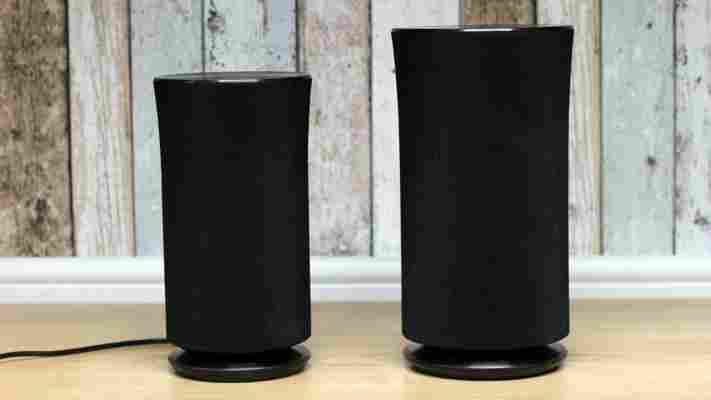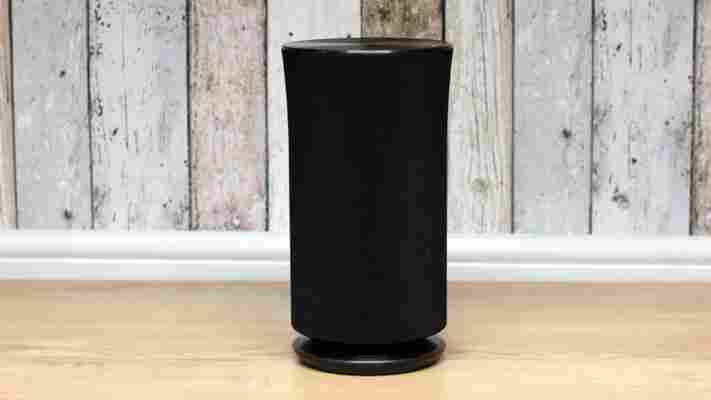Like other multiroom speakers manufacturers, Samsung has multiple models in its speaker ranges to help cater for the widest variety of rooms. The speaker you choose for your kitchen, for example, will likely differ from the one you want to put in your living room, so there are various different sizes to suit each scenario.
In Samsung's case, you have the diminutive R1, the medium-sized R3 reviewed here, and the larger R5 . However, rather than lose or gain drive units as you go up and down the R series - as is so often the case with multiroom audio speakers - the main difference between them is actually the size of their woofer. Whereas the R5 has a 5in woofer, the R3 makes do with a 4.2in woofer. Otherwise, the same 1in dome tweeter is exactly the same across all models, including the R1. As a result, this makes the R3 best-suited to smaller, secondary rooms like a bedroom or study rather than the main living room.
Design
In terms of its design, the R3 is definitely one of the strangest-looking speakers I've seen. Bearing a greater resemblance to an abstract black vase than a traditional speaker, the R3 and the rest of its family are quite unlike anything else on the market, making it a unique and attractive proposition for anyone looking for something a bit different.
There's a reason for its cylindrical shape, though, as the R3 has been specifically designed to produce omnidirectional audio to help reduce those dreaded blackspots when listening to music. To achieve this, there's a precision-calculated sound gap between the speaker driver and its acoustic lens. This can then be used to disperse the sound output evenly in every direction rather than the narrow forward-facing sound stage you normally associate with traditional speakers.

^ The R3 (left) is just a little shorter than the R5 (right)
From a purely numbers perspective, the R3 is e ssentially a shorter, more compact version of the R5. It measures 144mm in diameter at both ends and 273mm in height, and weighs 2kg, making it easy to pop on a desk or shelf without taking up too much space. Ideally, you'll want to place the R3 in the centre of your room to take advantage of its omnidirectional sound.
On top of the speaker, you'll find a textured, touch-sensitive surface that can be used to control media playback and adjust volume. A slick OLED interface shows you the device status and provides small animations when using swipe gestures to let you know you've done the action correctly, but its rather robotic readout of which mode the speaker's in when you turn it on can be quite jarring.
Setup and Multiroom
Unlike Samsung’s previous SHAPE range, there’s no longer any need to connect a separate hub to your router to setup your multiroom speakers. Instead, each speaker connects directly to your router, and you can connect up to 10 in total at any one time. There's no wired Ethernet port on the speakers either, so you’re limited to a wireless setup. Thankfully, the Samsung Multiroom app makes it easy to add your network settings to each speaker, and it shouldn’t take more than a few minutes before it's successfully connected.
Once set up, you then have access to a respectable range of streaming services including Spotify, through Spotify Connect integration, Deezer, 7digital, 8tracks, Murfie, Napster, Qobuz, Rdio and TuneIn. The app is well designed, and a big improvement on older versions in terms of visual flourishes. The app also makes it easy to group together different speakers for simultaneous playback, and lets you access music that's stored on networked storage and other local devices such as a phone or tablet. High-resolution audio is supported at up to 192kHz/24-bit in FLAC, AIFF and ALAC, too, as well as the usual array of formats such as MP3s.
You can also pair the R3 with a compatible Samsung television that supports TV SoundConnect and can be used in conjunction with a soundbar to create rear surround channels. You also have the option of connecting a device over Bluetooth, opening up your streaming options even further, but there’s no way to re-broadcast a Bluetooth device from one speaker to other speakers in a multiroom system. This is something I liked from Philips’ Izzy range and Libratone’s Zipp range and it’s a shame it’s not possible here. There's also no NFC or support for the aptX codec, which is a shame.

